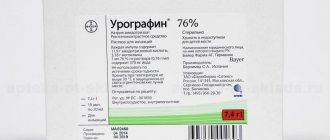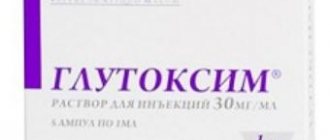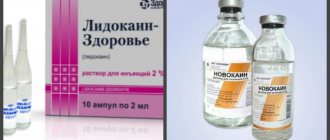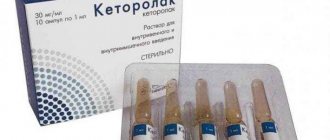Release form and composition
The drug is available in the form of an injection solution: a transparent, slightly yellowish or colorless liquid (1 ml in dark glass ampoules, 5 ampoules in blister packs; 5 packs in a cardboard box, 20 packs in a cardboard box, as well as instructions for use of Dexamethasone -Vial).
1 ampoule contains:
- active ingredient: dexamethasone phosphate, in the form of dexamethasone sodium phosphate – 4 mg;
- auxiliary components: glycerol, disodium edetate, sodium dihydrogen phosphate dihydrate, water for injection.
Analogs
Prednisolone
JSC Biosintez, Russia
The average cost is 21 rubles per package.
Prednisolone is a synthetic glucocorticosteroid drug that belongs to the same group of hormonal pharmacological agents. If we compare it with dexamethasone, it is several times weaker and has an average duration of action, unlike its analogue, which is longer. Prednisolone is also characterized by the fact that it has a weaker glucocorticoid effect and a more pronounced mineralocorticoid effect. Release forms: eye drops, injection solution, ointment and tablet form. Like its main analogue, it has a large list of possible side effects, so you need to use the medication carefully, in really difficult situations, with the minimum effective dosages in the shortest possible time. The list of contraindications is no less impressive, there are even more of them than in the analogue.
Pros:
- It's very cheap
- An effective drug.
Minuses:
- Many contraindications
- Lots of side effects.
Hydrocortisone
Tatchimpharmpreparaty, Russia
The average cost is 25 rubles per package.
Hydrocortisone is an earlier analogue of prednisolone and dexamethasone. Among all analogues, it has the weakest glucocorticoid activity, but at the same time the mineralocorticoid properties are the most pronounced. The mineralocorticoid property is characterized by increased excretion of potassium and calcium from the body, but at the same time sodium salts are excessively retained, causing the person to swell. Glucocorticoid activity – the ability to destroy muscle tissue and accumulate fat. Hydrocortisone is available in the form of external ointment, cream, suspension in injections, tablets, lyophilized powder in bottles for dilution.
Pros:
- Cheapness
- Large selection of release forms.
Minuses:
- Side effects
- Contraindications.
Pharmacological properties
Pharmacodynamics
Dexamethasone-Vial is a corticosteroid for systemic use with anti-inflammatory, antiallergic, desensitizing, antishock, antitoxic and immunosuppressive effects. Its active ingredient, dexamethasone, is a synthetic hormone of the adrenal cortex, a methylated derivative of fluoroprednisolone, which inhibits the release of interferon gamma, interleukin-1 and interleukin-2 from lymphocytes and macrophages.
A peculiarity of the action of Dexamethasone-Vial is the significant inhibition of pituitary gland function against the background of the almost complete absence of mineralocorticosteroid activity.
Dexamethasone, without reducing the concentration of circulating beta-endorphin, suppresses the pituitary gland's release of beta-lipotropin and adrenocorticotropic hormone (ACTH), the secretion of follicle-stimulating hormone (FSH) and thyroid-stimulating hormone (TSH). Increases the excitability of the central nervous system (CNS). By stimulating the production of erythropoietins, it helps to increase the number of red blood cells. Reduces the content of lymphocytes and eosinophils.
As a result of the interaction of dexamethasone with specific cytoplasmic receptors, a complex is formed that penetrates the cell nucleus and stimulates the synthesis of matrix ribonucleic acid (mRNA), which induces the formation of lipocortin and other proteins that mediate cellular effects. Lipocortin inhibits phospholipase A2, suppresses the release of arachidonic acid and the synthesis of endoperoxides, leukotrienes, prostaglandins, which contribute to the processes of allergy and inflammation.
By participating in protein metabolism, the substance helps reduce the amount of protein in plasma and enhance its catabolism in muscle tissue. Increases albumin synthesis in the liver and kidneys.
Dexamethasone affects lipid metabolism, increasing the synthesis of higher fatty acids and thyroglobulin (TG). By redistributing fat, it leads to its preferential accumulation in the face, abdomen, and shoulder girdle, causing the development of hypercholesterolemia.
As a result of the effect of Dexamethasone-Vial on carbohydrate metabolism, the absorption of carbohydrates from the gastrointestinal tract (GIT) increases. The activity of glucose-6-phosphatase increases, which leads to an increase in the flow of glucose into the blood from the liver. As a result of stimulation of phosphoenolpyruvate carboxylase and increased synthesis of aminotransferases, the process of gluconeogenesis is activated.
The effect on water-electrolyte metabolism is manifested by the retention of sodium and water ions in the body. The mineralocorticosteroid activity of dexamethasone stimulates the excretion of potassium ions, reduces the absorption of calcium ions from the gastrointestinal tract, increases their excretion by the kidneys and leaching from the bones.
The anti-inflammatory effect of Dexamethasone-Vial is due to the property of dexamethasone to inhibit the release of inflammatory mediators by eosinophils, induce the formation of lipocortin and reduce the number of mast cells that produce hyaluronic acid. It reduces capillary permeability, stabilizes cell membranes, organelle membranes (including lysosomal ones).
The antiallergic effect is a consequence of changes in the body's immune response as a result of Dexamethasone-Vial suppressing the synthesis and secretion of allergy mediators, delaying the release of histamine and other biologically active substances from sensitized mast cells and basophils. The effect also develops as a result of a decrease in the number of circulating basophils and the sensitivity of effector cells to allergy mediators, inhibition of the development of lymphoid and connective tissue, a decrease in the number of mast cells, T- and B-lymphocytes, and inhibition of antibody formation.
The effect of Dexamethasone-Vial in COPD (chronic obstructive pulmonary disease) is mainly based on the inhibition of processes such as inflammation, erosion and desquamation of the mucous membrane, eosinophilic infiltration of the submucosal layer of the bronchial epithelium. In addition, dexamethasone prevents or inhibits the development of edema of the mucous membranes. Promotes the deposition of circulating immune complexes in the bronchial mucosa, increasing sensitivity to endogenous catecholamines and exogenous sympathomimetics in small and medium bronchial beta-adrenergic receptors, reducing the viscosity of mucus by reducing its production.
The antishock and antitoxic effect is associated with the membrane protective properties of dexamethasone, a decrease in the permeability of the vascular wall, an increase in blood pressure (BP), and activation of liver enzymes that are involved in the metabolism of xeno- and endobiotics.
The immunosuppressive effect of Dexamethasone-Vial is due to inhibition of the release of cytokines (interleukin-1, interleukin-2 and interferon gamma) from lymphocytes and macrophages.
Suppresses the secretion and synthesis of ACTH, secondarily inhibits the synthesis of endogenous GCS. Reducing the rate of connective tissue reactions during the inflammatory process helps reduce the risk of scar tissue formation.
When taking a daily dose of 1–1.5 mg of dexamethasone, suppression of the adrenal cortex occurs. The duration of action on the hypothalamic-pituitary-adrenal system corresponds to the biological half-life of 32 to 72 hours.
The glucocorticosteroid activity of 0.5 mg dexamethasone is equivalent to approximately 3.5 mg prednisolone (or prednisone), 17.5 mg cortisone, or 15 mg hydrocortisone.
Pharmacokinetics
After intramuscular injection, absorption of dexamethasone occurs slowly. Its maximum concentration in plasma is reached after 7–9 hours.
Plasma protein binding at 80%.
Dexamethasone crosses the blood-brain and placental barrier. A small portion is excreted into breast milk.
Metabolism of the drug occurs in the liver. The half-life is 3–5 hours. Excreted through the kidneys.
Medicinal properties
Dexamethasone is a hormonal drug with potent glucocorticoid activity. It has antihistamine, anti-inflammatory, immunosuppressive, antishock, antitoxic and desensitizing properties. Improves the perception of beta-adrenergic receptors to catecholamines internally. After direct entry into the body, the drug enters into a specific interaction with cytoplasmic receptors, as a result of which complexes arise that enter the cell nucleus and stimulate m-RNA synthesis.
Thanks to increased stimulation of m-RNA, structural proteins are released that are responsible for regulating vital processes in the body. After the administration of a glucocorticoid, inhibition of phospholipase A2 is observed, the release of arachidonic acid, which suppresses mediators of pain, allergic reactions and inflammatory processes. There is also inhibition of the activity of protease, hyaluronic acid and collagen and eosinophils, as inflammatory mediators. In turn, this phenomenon provokes the following side effects:
- Decreased ACTH release
- The function of the matrix between the cells of bones and cartilage is normalized
- Retention of water and salt in the body
- Capillary permeability decreases
- Lysosomal cells are stabilized
- Decreased absorption and increased excretion of calcium in the urine
- Suppression of the release of cytokines, interferon and macrophages from lymphocytes
- The processes of glucose accumulation in the liver intensify
- Blood sugar processing slows down
- Increased protein breakdown
- Accumulation of fat deposits according to the android type (sides and abdomen)
- Involution of lymph tissue.
The active substance is highly soluble in fats and water, so it easily penetrates into all tissues and liquids. Absorbed almost completely if administered parenterally. The medication is processed in the liver into inactive metabolites and excreted primarily through the kidneys along with urine.
Indications for use
- Addisonian crisis (acute adrenal insufficiency or hypocortisolism);
- severe form of bronchial asthma, status asthmaticus;
- connective tissue diseases: rheumatoid arthritis, systemic lupus erythematosus;
- thyrotoxic (thyroid) crisis;
- acute hepatitis, hepatic coma;
- acute and severe forms of allergic reactions, anaphylactoid reactions, blood transfusion shock, anaphylactic shock;
- traumatic, burn, surgical or toxic shock (if other therapy is ineffective);
- swelling of the brain (including those associated with a brain tumor, surgery, head injury, or radiation therapy);
- poisoning with cauterizing liquids (in order to reduce inflammation and prevent cicatricial contractions).
Indications for use
Why is dexamethasone vial in ampoules prescribed? Typically, such a medication is prescribed for systemic effects on the body when hormonal therapy is required. Intravenous or intramuscular administration is an effective option when oral administration is not suitable or effective. Typically, injections are used for systemic autoimmune diseases, rheumatic or severe allergic lesions, cerebral edema, shock conditions, severe renal lesions, diseases of the respiratory system and circulatory system, in severe situations associated with dermatoses, as well as for the purpose of hormone replacement therapy (to for example, with adrenal insufficiency or pituitary adenoma).
Contraindications
The only absolute contraindication for short-term use of Dexamethasone-Vial for health reasons is individual intolerance to the components of the drug.
Intra-articular injection of the solution is contraindicated in the following conditions:
- previous arthroplasty;
- pathological bleeding (caused by the use of anticoagulants or endogenous);
- intra-articular bone fracture;
- infectious diseases, including septic (infectious) inflammatory process in the joint and periarticular infections (including medical history;
- severe periarticular osteoporosis;
- absence of signs of inflammation in the joint or the so-called “dry joint” (including osteoarthritis without synovitis);
- severe bone destruction;
- joint deformation, including sharp narrowing of the joint space, ankylosis;
- joint instability as a consequence of arthritis;
- aseptic necrosis of the epiphyses of the bones that form the joint.
The drug should not be used while breastfeeding.
Dexamethasone-Vial solution in ampoules should be prescribed with caution in the following cases: for infectious and parasitic diseases of viral, bacterial or fungal etiology, including those recently suffered or after recent contact with a patient (herpes simplex, viremic phase of herpes zoster, measles, chicken pox , amebiasis, established or suspected strongyloidiasis, active and latent tuberculosis, systemic mycosis); with lymphadenitis after vaccination with BCG (BCG - bacillus Calmette - Guerin), during the period 8 weeks before and 2 weeks after vaccination; for immunodeficiency conditions, including acquired immunodeficiency syndrome (AIDS) and human immunodeficiency virus (HIV) infections; for gastrointestinal pathologies such as esophagitis, gastric and duodenal ulcers, acute or latent peptic ulcers, gastritis, intestinal anastomosis (created recently), threat of perforation or abscess formation in ulcerative colitis, diverticulitis; for diseases of the cardiovascular system (including arterial hypertension, recent myocardial infarction, decompensated chronic heart failure, hyperlipidemia); for diseases of the endocrine system such as diabetes mellitus (including impaired carbohydrate tolerance), hypothyroidism, thyrotoxicosis, Itsenko-Cushing's disease; with severe chronic liver failure, nephrourolithiasis, severe chronic renal failure, hypoalbuminemia (including conditions predisposing to its occurrence), open- and closed-angle glaucoma, acute psychosis, myasthenia gravis, systemic osteoporosis, stage III–IV obesity, poliomyelitis (not including forms of bulbar encephalitis) and pediatric patients.
When administered intra-articularly, caution is required when administering Dexamethasone-Vial to patients with a general severe condition, as well as if there was ineffectiveness or short-term action of the two previous injections.
During pregnancy, the use of Dexamethasone-Vial is possible only in cases where the expected therapeutic effect for the mother, in the opinion of the doctor, exceeds the potential threat to the fetus.
Contraindications and precautions
An absolute contraindication, even if life is threatened, is intolerance or hypersensitivity to the active substance.
You should not use the medicine in the following situations:
- Infections and diseases caused by parasites, viruses and bacteria (worms, bacterial systemic disease, severe colds)
- Severe liver and kidney failure
- Fungal infection of a systemic nature
- Unbalanced mental state
- Too low immunity
- Diabetes mellitus type 1 and 2
- Preparatory period before and after vaccination
- Cardiovascular diseases
- Systemic osteoporosis, muscle atrophy
- Various diseases of the gastrointestinal tract - gastric and duodenal ulcers, colitis, intestinal anostomosis.
Intra-articular administration of the drug is prohibited when:
- Unstable condition of joint capsules
- Osteoporosis around the joint capsule
- Tendency to bleed
- In soft periarticular tissues
- Infection in joints and between spinal discs
- Previously performed arthroplasty.
Cross-drug interactions
The medication is not compatible with the concurrent use of any other medications, as there is a risk of insoluble compounds arising during interaction. The injection form is mixed only with a 5% glucose solution or 0.9% sodium chloride.
Dexamethasone-Vial, instructions for use: method and dosage
Dexamethasone-Vial solution in ampoules is intended for intravenous (IV), intramuscular (IM) and local (directly into the pathological formation, including intra-articular, subconjunctival, parabulbar, retrobulbar) administration.
IV administration is indicated for acute and emergency conditions; it can be done slowly in a stream or drip.
To prepare a solution for infusion, you must use a 5% dextrose solution or isotonic sodium chloride solution.
Dexamethasone should not be mixed with other drugs due to pharmaceutical incompatibility and the risk of the formation of insoluble compounds.
The doctor prescribes the dosage regimen taking into account clinical indications, the patient’s condition and individual response to therapy.
Recommended doses of Dexamethasone-Vial for various methods of administration of the solution:
- intra-articular administration: from 0.2 to 6 mg directly into the lesion 1 time in 3 days or with an interval of 21 days;
- IV or IM administration: 0.5–9 mg per day.
Dosage regimen depending on the diagnosed disease/condition:
- cerebral edema: first administration - 10 mg, then intramuscularly - 4 mg every 6 hours until symptoms disappear. After 2–4 days of therapy, the dose can be gradually reduced until the drug is completely discontinued from the fifth to the seventh day after the elimination of cerebral edema. Maintenance dose – 2 mg 3 times a day;
- shock: i.v. – 20 mg for the first injection. Next, the daily dose is determined taking into account the patient’s weight. For intravenous infusion - at the rate of 3 mg per 1 kg, for intravenous jet injection - 2-6 mg per 1 kg of weight in the form of one injection or 40 mg every 2-6 hours. As an alternative, a single intravenous injection of 1 mg per 1 kg of patient weight is possible. The duration of antishock therapy is usually 2–3 days, treatment is discontinued immediately after the patient’s condition has stabilized;
- diseases of allergic origin: intramuscularly - from 4 to 8 mg once, then the patient is transferred to taking oral dosage forms;
- prevention of nausea and vomiting during chemotherapy: IV – 8–20 mg 5–15 minutes before the chemotherapy session. Next, chemotherapy is carried out using oral dosage forms.
Recommended dosage of Dexamethasone-Vial for the treatment of children:
- respiratory distress syndrome of newborns: IM – 5 mg every 12 hours for 4 injections. Then, starting from the seventh day, 5 mg 1 time per day. The maximum daily dose is 80 mg;
- adrenal insufficiency: IM - at the rate of 0.023 mg per 1 kg of child weight or 0.67 mg per 1 m2 of body surface area 1 time in 3 days. As an alternative, you can use a dose of 0.0078–0.012 mg per 1 kg (0.23–0.34 mg per 1 m2) once a day, or 0.028–0.17 mg per 1 kg (0. 83–5 mg per 1 m2) 1–2 times a day.
Side effects
- from the endocrine system: decreased glucose tolerance, suppressed adrenal function, manifestation of latent diabetes mellitus or steroid diabetes mellitus, Itsenko-Cushing syndrome (increased blood pressure, pituitary obesity, moon face, hirsutism, amenorrhea, dysmenorrhea, stretch marks, myasthenia gravis), in children – delayed sexual development;
- from the digestive system: flatulence, hiccups, nausea, vomiting, decreased or increased appetite, pancreatitis, erosive esophagitis, steroid ulcer of the stomach and duodenum, bleeding and perforation of the gastrointestinal tract; rarely - increased activity of alkaline phosphatase and liver transaminases;
- from the cardiovascular system: increased severity or in predisposed patients the development of chronic heart failure, changes in the electrocardiogram (ECG) characteristic of hypokalemia, increased blood pressure, thrombosis, hypercoagulation, bradycardia (up to cardiac arrest), arrhythmias; in acute and subacute myocardial infarction - an increased risk of heart muscle rupture against the backdrop of slower formation of scar tissue and the spread of necrosis;
- from the nervous system: insomnia, nervousness (anxiety), dizziness, delirium, headache, disorientation, increased intracranial pressure, hallucinations, euphoria, manic-depressive psychosis, vertigo, depression, paranoia, convulsions, pseudotumor of the cerebellum;
- from the sensory organs: increased risk of developing secondary bacterial, fungal or viral eye infections, increased intraocular pressure (including damage to the optic nerve), trophic changes in the cornea, posterior subcapsular cataracts, exophthalmos, with parenteral administration in the head, turbinates, neck and skin head, sudden loss of vision is possible due to the deposition of drug crystals in the vessels of the eye;
- on the metabolic side: increased sweating, increased body weight, increased excretion of calcium ions, hypocalcemia, negative nitrogen balance due to increased protein breakdown;
- from the musculoskeletal system: steroid myopathy, osteoporosis (including pathological bone fractures), aseptic necrosis of the head of the femur and humerus, rupture of muscle tendons, atrophy (decreased muscle mass); in children – slowdown in growth and ossification processes against the background of premature closure of the epiphyseal growth zones;
- on the part of the skin and mucous membranes: steroid acne, slower wound healing, thinning of the skin, ecchymoses, petechiae, hypo- or hyperpigmentation, stretch marks, increased risk of developing candidiasis and pyoderma;
- allergic reactions: local allergic reactions, skin rash, itching, anaphylactic shock;
- local reactions: with parenteral administration - pain, burning, numbness, paresthesia, infection at the injection site; rarely - necrosis of surrounding tissues, scarring at the injection site; with intramuscular injection - atrophy of the skin and subcutaneous tissue (it is especially dangerous to inject the solution into the deltoid muscle); with intravenous administration – flushing of the face, arrhythmias, convulsions; with intra-articular injection – increased pain in the joint; with intracranial administration - nosebleeds;
- other: development or exacerbation of infections (usually due to the simultaneous use of immunosuppressants or vaccination), withdrawal syndrome, leukocyturia; side effects caused by mineralocorticosteroid activity - peripheral edema (fluid and sodium ion retention), hypernatremia, hypokalemic syndrome (hypokalemia, unusual weakness and fatigue, myalgia or muscle spasm, arrhythmia).
Side effects and overdose
The severity of side effects depends on the form of release (systemic or local), administered dosages, duration of use and individual characteristics of the patient. Systemic central nervous system side effects include:
- Exophthalmos of steroid origin
- Euphoria, delirium, depression, mania, hallucinations - changes in the psyche
- Non-inflammatory papilledema
- Increased intracranial pressure
- Poor vision and headaches
- Vertigo
- Insomnia
- Dizziness
- Cataracts and lens opacities
- Glaucoma
- Increased intraocular pressure
- Cataract
- Secondary infection of viral or fungal origin.
Cardiovascular disorders include:
- High blood pressure
- Rush of blood flow to the head
- Thrombosis
- A decrease in potassium and magnesium levels in the blood, which negatively affects cardiac activity
- Increased blood clotting
- Chronic heart failure - if prone.
Gastrointestinal tract:
- Vomiting, nausea, hiccups, heartburn
- Inflammation of the pancreas
- Stomach ulcer or gastritis
- Esophagitis
- Decreased or increased appetite.
Various metabolic disorders:
- Increased swelling due to retention of sodium salts in the body
- Deterioration of nitrogen balance
- Obesity
- Lack of calcium and potassium.
Various hormonal disorders:
- Hypercortisolism
- Hypocorticism
- Hidden course of diabetes mellitus
- Hormonal diabetes
- Increased body hair
- Closure of growth plates in children
- Menstrual irregularities in women of reproductive age.
Musculoskeletal system:
- Pain in muscles and joints
- Backache
- Osteoporosis
- Muscle weakness
- Rupture of tendons and ligaments
- Decreased muscle mass.
Leather:
- Stretch marks, mainly in the abdominal area
- Hyperhidrosis
- Thinning skin
- Acne steroid
- Poorly healing wounds.
Allergic reactions: rash, urticaria, swelling, shortness of breath, anaphylaxis. Withdrawal often results in weakness, decreased speed of reaction to stimuli, abdominal pain and refusal to eat. Locally, after the injection, a burning sensation, redness, allergy or slight infiltration, atrophy of the skin or subcutaneous fat, and pigmentation may occur.
Signs of overdose appear in proportion to the severity of side effects, which is why minimal doses are needed.
Use during pregnancy and lactation
During pregnancy, especially in the first trimester, the use of Dexamethasone-Vial is indicated only for health reasons, when the expected effect of therapy for the mother outweighs the potential risk for the fetus.
It should be taken into account that long-term therapy with dexamethasone during pregnancy increases the risk of fetal growth disorders, and use of the drug at the end of pregnancy increases the likelihood of developing adrenal atrophy in the fetus.
The use of Dexamethasone-Vial is contraindicated during breastfeeding.
If it is necessary to carry out drug therapy during lactation, breastfeeding should be stopped.
Drug interactions
- cardiac glycosides: the toxicity of cardiac glycosides is likely to increase, the risk of developing arrhythmias increases against the background of resulting hypokalemia;
- acetylsalicylic acid: accelerated excretion of acetylsalicylic acid occurs, a decrease in the level of its metabolites in the blood; if dexamethasone is discontinued, the level of salicylates in the blood increases and the risk of adverse reactions increases;
- isoniazid, mexiletine: metabolism increases, thereby reducing their plasma level, especially in patients with rapid acetylation processes;
- paracetamol: the risk of hepatotoxicity of paracetamol associated with the induction of liver enzymes and the formation of a toxic metabolite of paracetamol increases;
- somatropin: high doses of dexamethasone reduce the therapeutic activity of somatropin;
- hypoglycemic drugs: their effectiveness decreases;
- coumarin derivatives: dexamethasone enhances their anticoagulant effect;
- GCS, thiazide diuretics, amphotericin B, carbonic anhydrase inhibitors: these drugs in combination with dexamethasone increase the risk of hypokalemia;
- sodium-containing drugs: contribute to increased blood pressure and the occurrence of edema;
- cyclosporine, ketoconazole: these drugs increase the toxicity of dexamethasone by inhibiting metabolism and reducing its clearance;
- non-steroidal anti-inflammatory drugs (NSAIDs), ethanol: the likelihood of developing ulcerations of the gastrointestinal mucosa and bleeding increases. In the treatment of arthritis, a combination with NSAIDs is possible while reducing the dose of dexamethasone;
- indomethacin: the risk of developing side effects of the drug increases when combined with indomethacin, which displaces dexamethasone from its connection with albumin;
- amphotericin B, carbonic anhydrase inhibitors: the risk of osteoporosis increases with concomitant therapy with dexamethasone;
- barbiturates, ephedrine, phenytoin, theophylline, rifampicin and other inducers of microsomal liver enzymes: the influence of these drugs helps to increase the rate of metabolism of the drug and reduce its therapeutic effect;
- inhibitors of adrenal cortex function: taking mitotane and other inhibitors of adrenal cortex function may require increasing the dose of Dexamethasone-Vial;
- thyroid hormones: dexamethasone clearance increases during therapy with thyroid hormones;
- immunosuppressants: increase the risk of developing infections, lymphoma and other lymphoproliferative disorders caused by the Epstein-Barr virus;
- ergocalciferol, parathyroid hormone: prevent the development of osteopathy caused by the drug;
- praziquantel: the concentration of praziquantel in the blood decreases;
- steroid hormonal drugs (anabolics, androgens, estrogens and oral contraceptives): in combination with dexamethasone, they contribute to the appearance of acne and hirsutism;
- tricyclic antidepressants: in combination with them, dexamethasone can increase the severity of depression caused by taking GCS;
- other corticosteroids, antipsychotic drugs (neuroleptics), carbutamide, azathioprine: when combined with these drugs, the risk of developing cataracts increases;
- estrogens: oral estrogen-containing contraceptives and other estrogens help reduce clearance, lengthen the half-life of the drug, prolong its therapeutic and toxic effects;
- muscle relaxants: drug-induced hypokalemia during the use of muscle relaxants may increase the severity and duration of muscle blockade;
- m-anticholinergics (including antihistamines, tricyclic antidepressants), nitrates: the influence of these drugs contributes to an increase in intraocular pressure;
- folic acid: its content increases with long-term therapy;
- live antiviral vaccines: the risk of developing infections and viral activation increases with all types of immunization, including live antiviral vaccines;
- vitamin D: dexamethasone weakens its effect on the absorption of calcium ions in the intestinal lumen;
- Iofendylate: When administered intrathecally in combination with dexamethasone, the likelihood of developing arachnoiditis increases.
Reviews about Dexamethasone-Vial
Reviews of Dexamethasone-Vial are positive. Patients indicate the high efficiency and rapid action of the drug in emergency cases. They describe situations where Dexamethasone-Vial stopped the development of allergic dermatitis and, as a concomitant effect, significantly relieved the pain from heel spurs. The solution is used to relieve swelling from insect bites (wasps, bees), including in veterinary practice. Experts recommend that you always have this injection in your emergency kit, which is indispensable for allergies, croup, meningitis, and shock.
The disadvantages include an extensive list of contraindications and side effects. There are complaints of tachycardia and heartburn.
It is noted that Dexamethasone-Vial ampoules are easy to open, thanks to a special mark at the break site, but their quantity in the package (25 pieces) is too large, since the solution is usually used for a short course.





